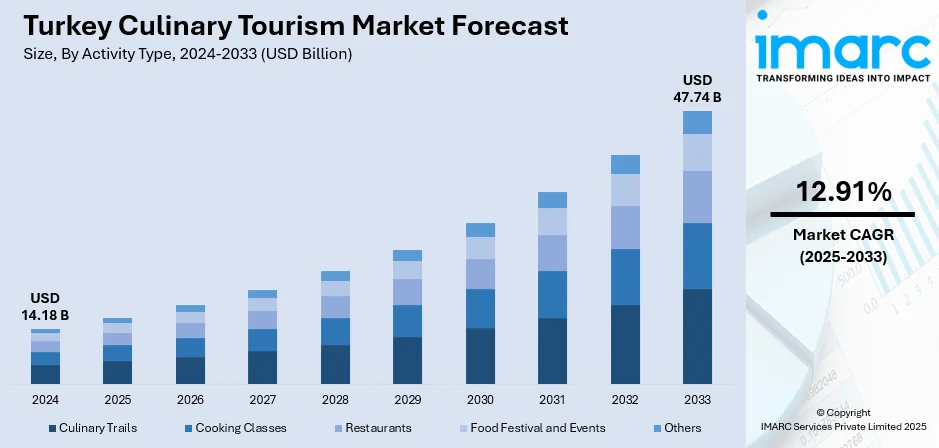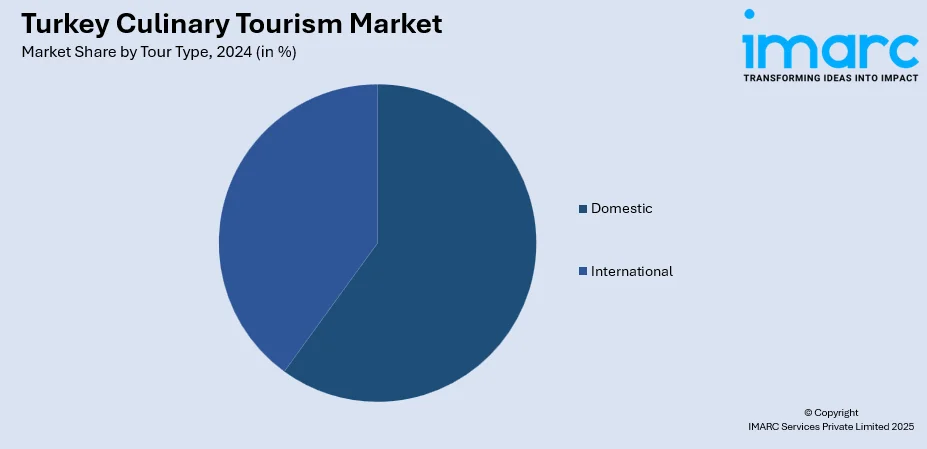
Turkey Culinary Tourism Market Size, Share, Trends and Forecast by Activity Type, Tour Type, Age Group, Mode of Booking, and Region, 2025-2033
Turkey Culinary Tourism Market Overview:
The Turkey culinary tourism market size reached USD 14.18 Billion in 2024. Looking forward, IMARC Group expects the market to reach USD 47.74 Billion by 2033, exhibiting a growth rate (CAGR) of 12.91% during 2025-2033. Turkey's food tourism industry is driven by the richness and diversity of food culture in the country, which is constantly drawing international travelers. Moreover, government and private sector partnerships that are continually marketing the country as an international gastronomy destination are contributing to the market growth. Additionally, heightened global demand for experiential travel is expanding the Turkey culinary tourism market share.
|
Report Attribute
|
Key Statistics
|
|---|---|
|
Base Year
|
2024
|
|
Forecast Years
|
2025-2033
|
|
Historical Years
|
2019-2024
|
| Market Size in 2024 | USD 14.18 Billion |
| Market Forecast in 2033 | USD 47.74 Billion |
| Market Growth Rate 2025-2033 | 12.91% |
Turkey Culinary Tourism Market Trends:
Diverse Culinary Heritage and Regional Variation
Turkey's food tourism industry is driven by the richness and diversity of food culture in the country, which is constantly drawing international travelers. The nation is providing a distinct mix of flavors consisting of Central Asian, Middle Eastern, Mediterranean, and Balkan dimensions, rendering its cuisine a cultural draw in itself. Tourists are increasingly visiting Turkish areas like Gaziantep, Hatay, and Istanbul, where food festivals, street markets, and culinary trails are now promoting local cuisine and classic recipes. Fresh ingredients, classic cooking processes, and recipes hundreds of years old are being used as part of a tourist experience. Tour operators are developing food-focused packages involving cooking lessons, vineyard tours, and local market outings to help tourists experience Turkish culture more intensely. By highlighting food as a cultural and touristic resource, Turkey is continually reinforcing its status as a top culinary tourism destination globally. For instance, in 2024, Gastroshow, organized in partnership between Turkuvaz Media Group and the Gastronomy Tourism Association, took place to highlight the strong bond shared by gastronomy and tourism in the country.

To get more information on this market, Request Sample
Government and Private Sector Promotion of Gastronomy Tourism
Turkey's food tourism sector is being specifically pushed by the government and private sector partnerships that are continually marketing Turkey as an international gastronomy destination. The Ministry of Culture and Tourism regularly announces campaigns and projects that identify Turkey's food, promoting it as a key component of cultural travel. Cities such as Gaziantep are being acknowledged by UNESCO for their gastronomy, which is further boosting Turkey's food tourism brand. Restaurants, hotels, and travel agencies are meanwhile pouring money into culinary experiences in the form of tasting menus, food tours, and themed stays to tap into this increasing demand. Gastronomy festivals such as the International Istanbul Gastronomy Festival are meanwhile being held regularly, presenting Turkish cuisine to a worldwide audience. By dovetailing public and private initiatives, Turkey is being placed in the market as a place where gastronomy and cultural heritage are converging, driving sustained growth in culinary tourism.
Increased Global Interest in Food and Experiential Travel
The Turkish culinary tourism market growth is propelled by the increasing global demand for experiential travel, with tourists craving authentic, participatory experiences instead of passive observation. Tourists are desiring more chances to learn, taste, and engage in local cuisine traditions, and Turkey is responding with intensive programs. Cooking courses, rural food walking tours, and farm-to-table activities are being incorporated into holiday packages so that tourists can engage with local farmers, chefs, and artisans. The international trend of highlighting food as a gateway to culture is being translated into Turkey's increasing tourist figures, as visitors are linking Turkish food to wellness, authenticity, and cultural richness. Social media is constantly promoting this trend, with tourists posting food experiences such as Turkish breakfast tables, baklava, or street kebabs, creating viral interest in culinary tourism. This shift toward experiential tourism is being leveraged by Turkey. Moreover, as per the World Tourism Forum, the tourist population increased by 9% in 2025 compared to the first half of the previous year in Turkey. This also increased the need for comprehensive culinary tourism packages.
Turkey Culinary Tourism Market Segmentation:
IMARC Group provides an analysis of the key trends in each segment of the market, along with forecasts at the country and regional levels for 2025-2033. Our report has categorized the market based on activity type, tour type, age group, and mode of booking.
Activity Type Insights:
- Culinary Trails
- Cooking Classes
- Restaurants
- Food Festival and Events
- Others
The report has provided a detailed breakup and analysis of the market based on the activity type. This includes culinary trails, cooking classes, restaurants, food festival and events, and others.
Tour Type Insights:

- Domestic
- International
A detailed breakup and analysis of the market based on the tour type have also been provided in the report. This includes domestic and international.
Age Group Insights:
- Baby Boomers
- Generation X
- Generation Y
- Generation Z
The report has provided a detailed breakup and analysis of the market based on the age group. This includes baby boomers, generation X, generation Y, and generation Z.
Mode of Booking Insights:
- Online Travel Agents
- Traditional Agents
- Direct Bookings
A detailed breakup and analysis of the market based on the mode of booking have also been provided in the report. This includes online travel agents, traditional agents, and direct bookings.
Regional Insights:
- Marmara
- Central Anatolia
- Mediterranean
- Aegean
- Southeastern Anatolia
- Black Sea
- Eastern Anatolia
The report has also provided a comprehensive analysis of all the major regional markets, which include Marmara, Central Anatolia, Mediterranean, Aegean, Southeastern Anatolia, Black Sea, and Eastern Anatolia.
Competitive Landscape:
The market research report has also provided a comprehensive analysis of the competitive landscape. Competitive analysis such as market structure, key player positioning, top winning strategies, competitive dashboard, and company evaluation quadrant has been covered in the report. Also, detailed profiles of all major companies have been provided.
Turkey Culinary Tourism Market Report Coverage:
| Report Features | Details |
|---|---|
| Base Year of the Analysis | 2024 |
| Historical Period | 2019-2024 |
| Forecast Period | 2025-2033 |
| Units | Billion USD |
| Scope of the Report |
Exploration of Historical Trends and Market Outlook, Industry Catalysts and Challenges, Segment-Wise Historical and Future Market Assessment:
|
| Activity Types Covered | Culinary Trails, Cooking Classes, Restaurants, Food Festival and Events, Others |
| Tour Types Covered | Domestic, International |
| Age Groups Covered | Baby Boomers, Generation X, Generation Y, Generation Z |
| Mode of Bookings Covered | Online Travel Agents, Traditional Agents, Direct Bookings |
| Regions Covered | Marmara, Central Anatolia, Mediterranean, Aegean, Southeastern Anatolia, Black Sea, Eastern Anatolia |
| Customization Scope | 10% Free Customization |
| Post-Sale Analyst Support | 10-12 Weeks |
| Delivery Format | PDF and Excel through Email (We can also provide the editable version of the report in PPT/Word format on special request) |
Key Questions Answered in This Report:
- How has the Turkey culinary tourism market performed so far and how will it perform in the coming years?
- What is the breakup of the Turkey culinary tourism market on the basis of activity type?
- What is the breakup of the Turkey culinary tourism market on the basis of tour type?
- What is the breakup of the Turkey culinary tourism market on the basis of age group?
- What is the breakup of the Turkey culinary tourism market on the basis of mode of booking?
- What is the breakup of the Turkey culinary tourism market on the basis of region?
- What are the various stages in the value chain of the Turkey culinary tourism market?
- What are the key driving factors and challenges in the Turkey culinary tourism market?
- What is the structure of the Turkey culinary tourism market and who are the key players?
- What is the degree of competition in the Turkey culinary tourism market?
Key Benefits for Stakeholders:
- IMARC’s industry report offers a comprehensive quantitative analysis of various market segments, historical and current market trends, market forecasts, and dynamics of the Turkey culinary tourism market from 2019-2033.
- The research report provides the latest information on the market drivers, challenges, and opportunities in the Turkey culinary tourism market.
- Porter's five forces analysis assist stakeholders in assessing the impact of new entrants, competitive rivalry, supplier power, buyer power, and the threat of substitution. It helps stakeholders to analyze the level of competition within the Turkey culinary tourism industry and its attractiveness.
- Competitive landscape allows stakeholders to understand their competitive environment and provides an insight into the current positions of key players in the market.
Need more help?
- Speak to our experienced analysts for insights on the current market scenarios.
- Include additional segments and countries to customize the report as per your requirement.
- Gain an unparalleled competitive advantage in your domain by understanding how to utilize the report and positively impacting your operations and revenue.
- For further assistance, please connect with our analysts.
 Request Customization
Request Customization
 Speak to an Analyst
Speak to an Analyst
 Request Brochure
Request Brochure
 Inquire Before Buying
Inquire Before Buying




.webp)




.webp)












